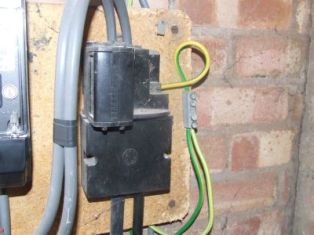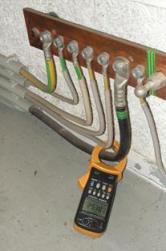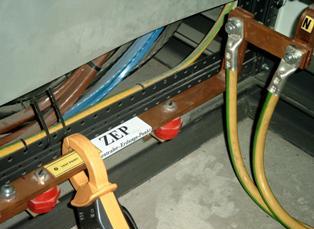Natural grounding wires, grounding loops and grounding wires
Natural grounding
To obtain grounding devices with low resistance, so-called natural grounds: water and other pipes laid in the ground, metal structures well connected to the ground, etc. Such natural grounded electrodes can have a resistance of the order of fractions of an ohm and do not require special costs for their arrangement. Therefore, they should be used first.
In cases where such natural grounding conductors are absent, for grounding devices it is necessary to arrange artificial grounding such as grounding loops, which are rows of angles or pipes driven into the ground, connected by steel strips.
Total leakage resistance of the grounding loop is determined by the leakage resistance of individual grounded electrodes according to the well-known law of electrical engineering (as a sum of the conductances of parallel connected conductors). However, the phenomenon of the so-called mutual shielding of earthed electrodes must be taken into account with loop earth electrodes.This phenomenon leads to an increase in the resistance against scattering of grounded electrodes located in the grounding loop, compared to individual grounding electrodes (corner, strip, etc.) by about 1.5 and even up to 5-6 times (for particularly complex schemes) ). The closer the grounding switches are to each other, the more the mutual shielding affects the total leakage resistance. Therefore, individual grounding electrodes must be located with distances between them of at least 2.5 and up to 5 m.
The coefficients that account for the increase in splash resistance as a result of the mutual protection degree of use of earthed electrodes are called. All parts of the ground loop are at approximately the same potential when a ground fault current flows through it. That is why ground loops contribute to the equalization of potentials in the area they occupy... In some cases (for example, in installations with a voltage of 110 kV and more, laboratory installations with high voltage, etc.) they are specially arranged for this purpose in the form of a fairly common grid of strips (in addition to pipes or corners).

Ground wires
The implementation of grounding networks is facilitated by using steel structures for various purposes as grounding conductors. We will conventionally call them natural conductors.
The following can serve as natural conductors:
a) metal constructions of buildings (trusses, columns, etc.),
b) metal structures for industrial purposes (crane tracks, distribution frames, galleries, platforms, elevator shafts, hoists, etc.),
c) metal pipelines for all purposes — water supply, sewage, heating, etc.(except pipelines for flammable and explosive mixtures),
d) steel pipes for electrical wiring,
e) lead and aluminum sheaths (but not armor) of cables.
They can serve as the only ground conductors if they meet the requirements PUE in terms of cross section or conductivity (resistance).
Steel is primarily used as grounding conductors. For lighting installations and in other cases where the use of steel is structurally inconvenient or the conductivity is insufficient, copper or aluminum are used.
Grounding conductors are divided into main (trunk) and branch from them to separate power consumers.
Grounding conductors must have the minimum dimensions specified in the PUE.
In electrical installations with a voltage of up to 1000 V with an isolated neutral, the permissible load of the main grounding conductors in accordance with the requirements of PUE must be at least 50% of the permissible continuous load on the phase conductor of the most powerful line of this section of the network and the permissible load of the branches of the grounding wires to individual energy consumers — at least 1/3 of the permissible load of the phase wires feeding these electrical receivers.
For grounding conductors with a voltage up to and above 1000 V, cross sections of more than 100 mm for steel, 35 mm2 for aluminum and 25 mm2 for copper are not required.
Thus, the selection of conductors for equipment grounding is quite simple, since the permissible load of various conductors can be obtained from the PUE tables or electrical reference books.
 The situation is more complicated with the selection of grounding conductors for 380/220 and 220/127 V installations with a grounded neutral. The interruption of the emergency section occurs if there is a certain value of the short-circuit current; therefore, it is necessary to have the lowest possible short-circuit resistance where, in the event of an emergency, the current would reach the required value for the protection to operate. The current value according to PUE requirements must exceed at least 3 times the rated fuse current of the nearest fuse or 1.5 times the maximum release current of the nearest machine. This requirement ensures that the fuse blows and the machine shuts down. This is the first PUE requirement regarding grounding devices.
The situation is more complicated with the selection of grounding conductors for 380/220 and 220/127 V installations with a grounded neutral. The interruption of the emergency section occurs if there is a certain value of the short-circuit current; therefore, it is necessary to have the lowest possible short-circuit resistance where, in the event of an emergency, the current would reach the required value for the protection to operate. The current value according to PUE requirements must exceed at least 3 times the rated fuse current of the nearest fuse or 1.5 times the maximum release current of the nearest machine. This requirement ensures that the fuse blows and the machine shuts down. This is the first PUE requirement regarding grounding devices.
A single-phase circuit in a network with a grounded neutral includes resistances: windings (and magnetic circuit) of the transformer, phase wire, neutral wire (neutral wire). The transformer and phase conductor are selected according to the load and other factors unrelated to the grounding system.
The following requirement is prescribed for the zero wire (zero wire) of the PUE: its resistance must not exceed more than 2 times the resistance of the phase wire of the most powerful line of those feeding the electrical installation or electrical receiver (or the conductivity must be the most a little 50% of the conductivity of the phase wire). This is the second PUE requirement regarding grounding devices.
The first requirement is in most cases automatically fulfilled if the second requirement is met.Thus, it is mainly necessary to ensure the required resistance value of the neutral wire (neutral wire). To do this, it is necessary to take the cross section of the zero (neutral) wire equal to 50% of the phase.
The correct selection of neutral conductors is of particular importance for safety.

